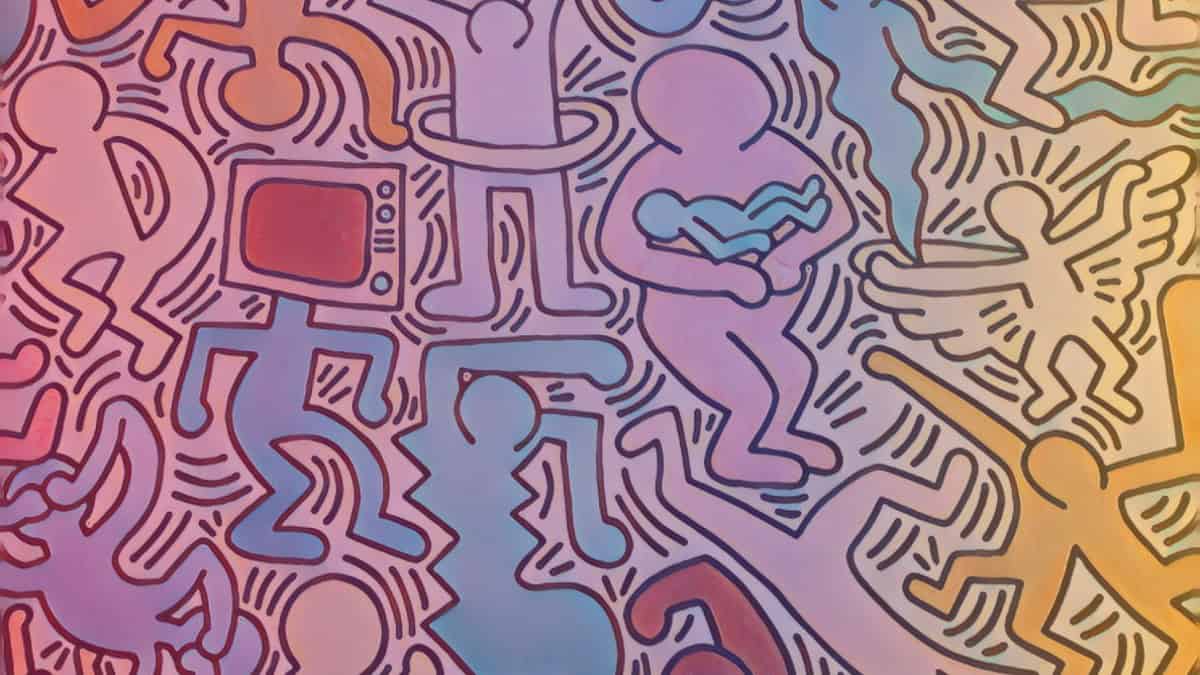Key Takeaways
- A retrospective exhibition on the artist Keith Haring is set to begin at The Broad Museum in Los Angeles on May 27. Haring's work, characterized by hieroglyphics and coloring-book outlines, gained recognition from street art to gallery pieces, eventually selling for millions.
- Haring's rise in the art world occurred during the influx of artistic aspirants into New York City in the 1970s. His work resonates with the likes of Andy Warhol and Jean-Michel Basquiat.
- The exhibition, titled "Keith Haring: Art Is for Everybody," will travel to the Art Gallery of Ontario in Toronto and the Walker Art Center in Minneapolis.
- Haring's artistic journey began in Pennsylvania, where he displayed an early talent for drawing. He later moved to New York in 1978 to study at the School of Visual Arts.
- In New York, Haring found a city experiencing a cultural renaissance, which influenced his work. He was particularly inspired by the graffiti movement and the vibrant downtown art scene.
- Haring's iconic symbols, such as the "radiant baby," became widely recognized and played a significant role in defining his work. He expanded his artistic endeavors to include canvas painting, sculpture, performance, and murals.
- Despite his untimely death from AIDS at the age of 31, Haring left behind a prolific body of work that continues to captivate audiences. His impact on pop culture remains evident, with his distinct style still influencing contemporary merchandise.
- Several books provide comprehensive coverage of Haring's life and work, including "Keith Haring Journals," "Keith Haring's Line: Race and the Performance of Desire," "Keith Haring: The Boy Who Just Kept Drawing," and "Keith Haring: The Authorized Biography."
- Haring's legacy endures through his art and the inspiration he continues to provide. The upcoming retrospective exhibition at The Broad in Los Angeles is expected to draw large crowds and explore Haring's extensive body of work.
- The exhibition reflects Haring's belief that "Art is for everybody," emphasizing the accessibility and impact of his art.
Keith Haring, an artist who stormed onto the scene in his early 20s, is the subject of an illustrious traveling retrospective that is set to commence at The Broad Museum in Los Angeles on May 27.
His work, an amalgamation of hieroglyphics and coloring-book outlines, was characterized by an impressive transition from street art to gallery pieces to auction-worthy masterpieces, selling for millions.
Despite his untimely death due to AIDS in 1990 at the age of 31, Haring’s legend lives on, with a resonance on par with the likes of Andy Warhol and Jean-Michel Basquiat.
His meteoric rise coincided with the influx of artistic aspirants into New York City, when the city was grappling with municipal bankruptcy in the 1970s.
Haring’s Midcentury Influences
Haring’s generation was heavily influenced by midcentury mass media, which included not just television, but also the burgeoning rock-and-roll music scene and comic books.
TV brought world-shattering events directly into suburban living rooms, transforming images into a universally shared language.
Much like other artists of his time, Haring also realized that 20th-century modernism had reached its peak after Conceptual Art and Minimalism, which necessitated a return to representation.
This saw Haring revive a more energetic and democratized form of Pop Art.
The exhibition “Keith Haring: Art Is for Everybody” will travel from Los Angeles to the Art Gallery of Ontario in Toronto and later, the Walker Art Center in Minneapolis.
From Small Town Beginnings to NYC Stardom
Born in Reading, Pennsylvania, and raised in the predominantly white town of Kutztown, Haring displayed an early aptitude for drawing.
His artistic journey began under the tutelage of his father, who introduced him to cartooning.
Haring’s early forays into the art world were unconventional. He sold self-designed Grateful Dead and anti-Nixon T-shirts while hitchhiking across the country.
He briefly attended the Ivy School of Professional Art in Pittsburgh before moving to New York in 1978 to study at the School of Visual Arts on a scholarship.
His symbolic creations, including flying saucers, human bodies with barking dog heads, and most notably, his “radiant baby,” became instantly recognizable and played a significant role in defining his work.

A New York Renaissance
Upon his arrival, Haring found a city experiencing a cultural renaissance amid chaos and decay. It was during this period that Haring was heavily influenced by the graffiti movement which originated in the Bronx and Brooklyn.
The vibrant culture and art world downtown, with its thriving club scene, created a synergy that was influential in shaping Haring’s work.
Haring adopted the subway as his canvas, spontaneously creating images on black paper that covered vacant advertising frames.
His symbolic creations, including flying saucers, human bodies with barking dog heads, and most notably, his “radiant baby,” became instantly recognizable and played a significant role in defining his work.
An Expansive Portfolio and Legacy
As his career evolved, Haring expanded his work to include not just graffiti, but also canvas painting, sculpture, and performance.
His collaboration with choreographer Bill T. Jones is notably known for its creative fusion of dance and art.
He also painted several murals, including a memorable anti-drug message, “Crack Is Wack”, in Harlem and an all-embracing piece for the Gay Men’s Health Crisis bathroom, a testament to his AIDS activism.
Despite his untimely death, Haring left a prolific and refined body of work that continues to captivate audiences today.
His impact on pop culture remains evident, with his distinct thick-line cartoon style still making appearances on contemporary merchandise like t-shirts and trainers.
Further Reading and Exploring Keith Haring
For those seeking to delve deeper into the life and work of Keith Haring, a selection of books provides comprehensive coverage.
Among them is the “Keith Haring Journals” (2010), which offers key insights into the artist’s thinking process, his perspectives on art, and his experiences as he rose to fame.
The book “Keith Haring’s Line: Race and the Performance of Desire” (2020) by Ricardo Montez critically examines Haring’s relationship to race in the 1980s and sheds light on his collaborations with other artists.
Meanwhile, “Keith Haring: The Boy Who Just Kept Drawing” (2017) by Kay Haring, the artist’s sister, provides a more personal biography suited for young audiences.
It tells the inspiring story of the world-renowned artist from childhood onwards.
John Gruen’s “Keith Haring: The Authorized Biography” (1992) is an early posthumous account of Haring’s life and career, containing reflections by the artist himself, his family, and friends.
The book also features insights from a variety of individuals who knew Haring, including artist Roy Lichtenstein, pop star Madonna, and beat poet William Burroughs.
A new biography by Brad Gooch is also anticipated for publication next year, promising to leave no stone unturned in its exploration of Haring’s life and work.
Haring’s legacy persists, not only through his art, but also through the impact he had on those who knew him and the countless individuals his work continues to inspire.
The upcoming retrospective exhibition at The Broad in Los Angeles is expected to draw large crowds, as audiences are drawn to explore the extensive body of work left behind by this groundbreaking artist.
Haring once said, “Art is for everybody,” and it appears that, through his enduring influence and the continuous exploration of his work, he was right.
Exhibition details: “Keith Haring: Art Is for Everybody,” The Broad, Los Angeles, May 27-October 8, 2023.








